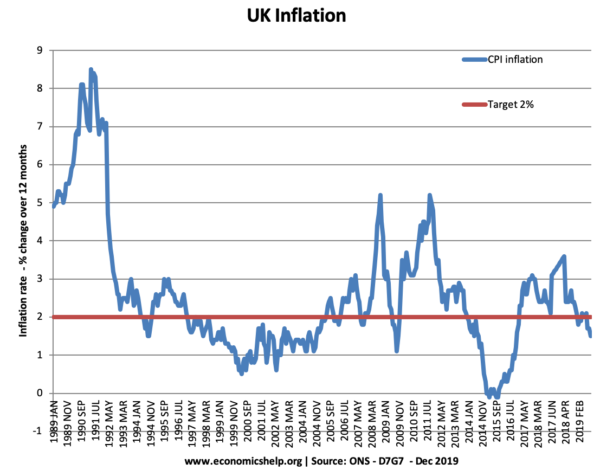An interesting question at the moment is to what extent does temporary cost-push factors lead to a permanent rise in underlying inflation?
Temporary cost-push factors include rising commodity prices, rising food prices, higher taxes. These goods are often volatile so the increase is often temporary. In the case of taxes, the price increases last for just a year.
How Temporary Inflation Pressures Can Lead to Higher Permanent Inflation
Wage Push Factors. If prices rise, workers may demand a corresponding wage increase to maintain living standards. Wages are an important factor in determining inflation because if wages rise:
- Consumers will have more income to spend
- Firms will have higher costs and so tend to pass these onto consumers in the form of higher prices.
Therefore, if trades unions are able to bargain for higher wages, a temporary cost-push inflation could lead to a wage-price spiral and permanent inflation
Expectations. If prices rise in one year, it may change inflation expectations. The model of adaptive expectations suggests people expectations of future inflation depends on current inflation. Therefore if there is a temporary rise in prices, consumers and firms may feel this is a permanent rise in inflation. Therefore, in anticipating higher inflation it will lead to higher wages and higher prices.
The credibility of Monetary Policy. If the Bank of England keep saying inflation is just temporary and should disappear soon, people may lose confidence in the Bank of England to keep inflation low.
Temporary Inflation May Not Cause Permanent Inflation
Spare Capacity If unemployment is low and the economy growing strongly, it is easier for unions to gain wage increases in response to temporary inflation. If the economy is in recession and unemployment high, it is difficult to get wage increases, despite higher inflation.
Strength of Unions In the 1970s, trades unions were more powerful, they had more leverage. They were successful in bargaining for higher wages. However, in the UK economy, unions have less power to bargain for higher wages.
The below graphs show how the 2008 inflation spike did not lead to higher core inflation in either US or Europe.

Difference between Core Inflation and CPI
Conclusion
In the 1970s, cost-push factors did cause a significant rise in underlying inflation as it contributed to a wage-price spiral. But, in the present situation of high unemployment, weak unions and sluggish growth, it is hard to see wages spiralling out of control.
It does mean, unfortunately, that many may have a decline in living standards – a decline in real wages as headline inflation increases faster than nominal wages.
Related

